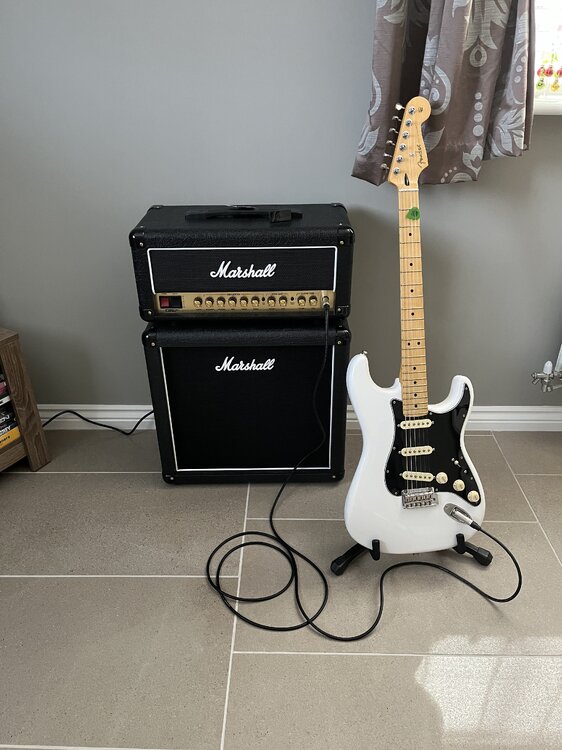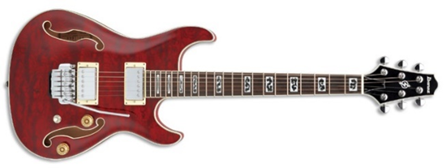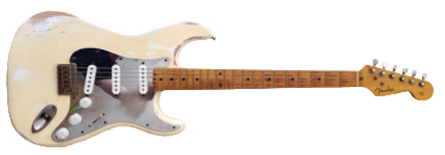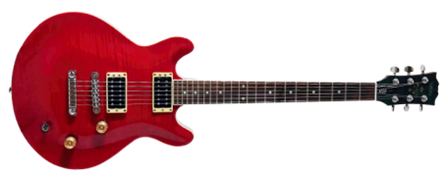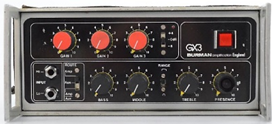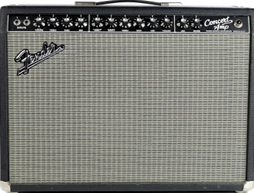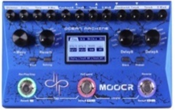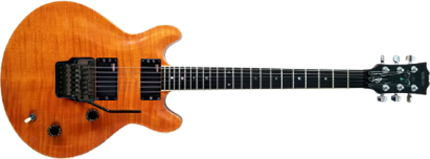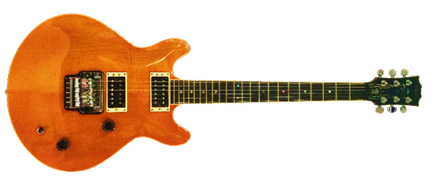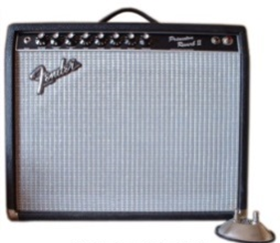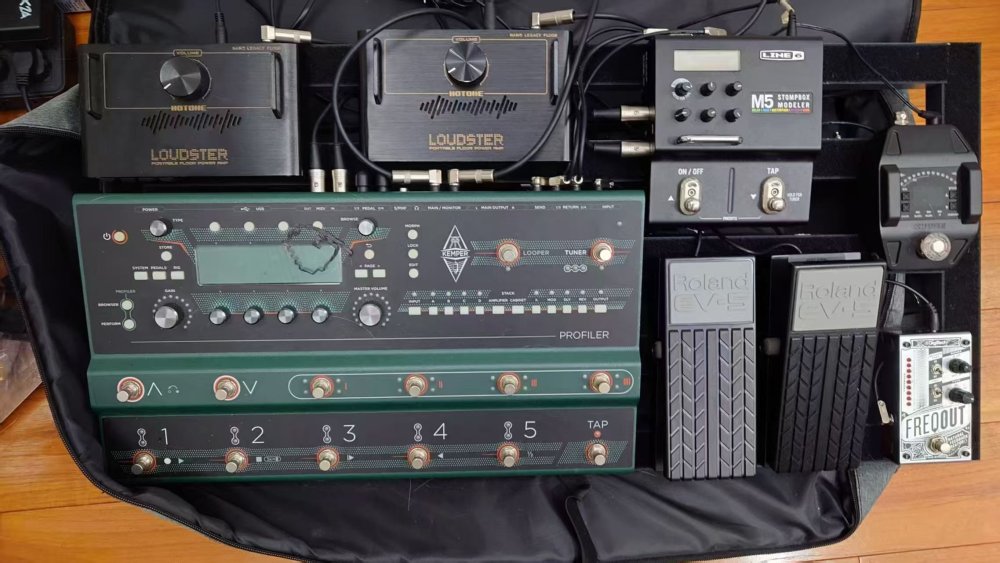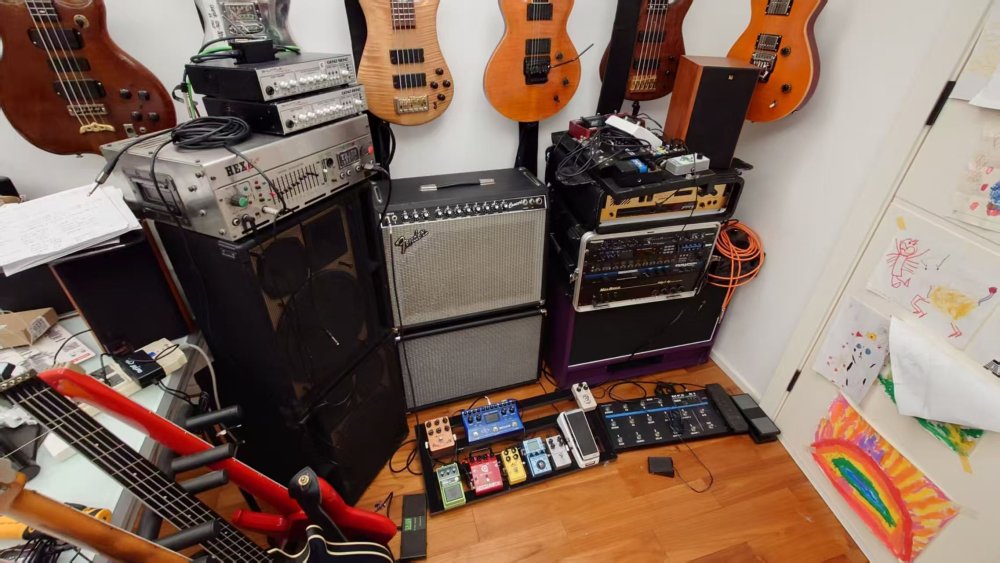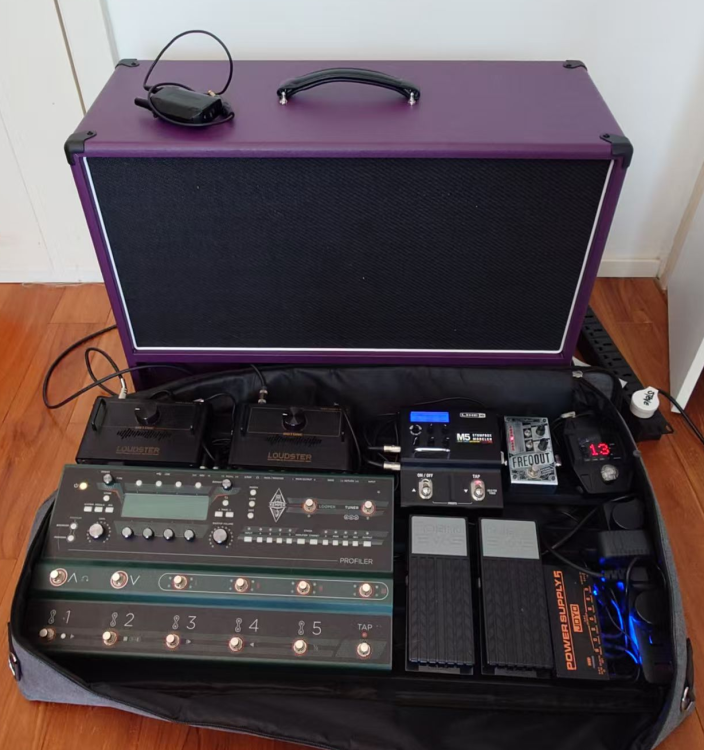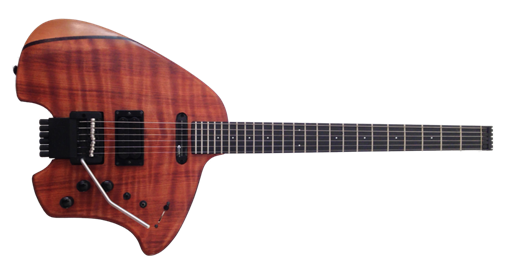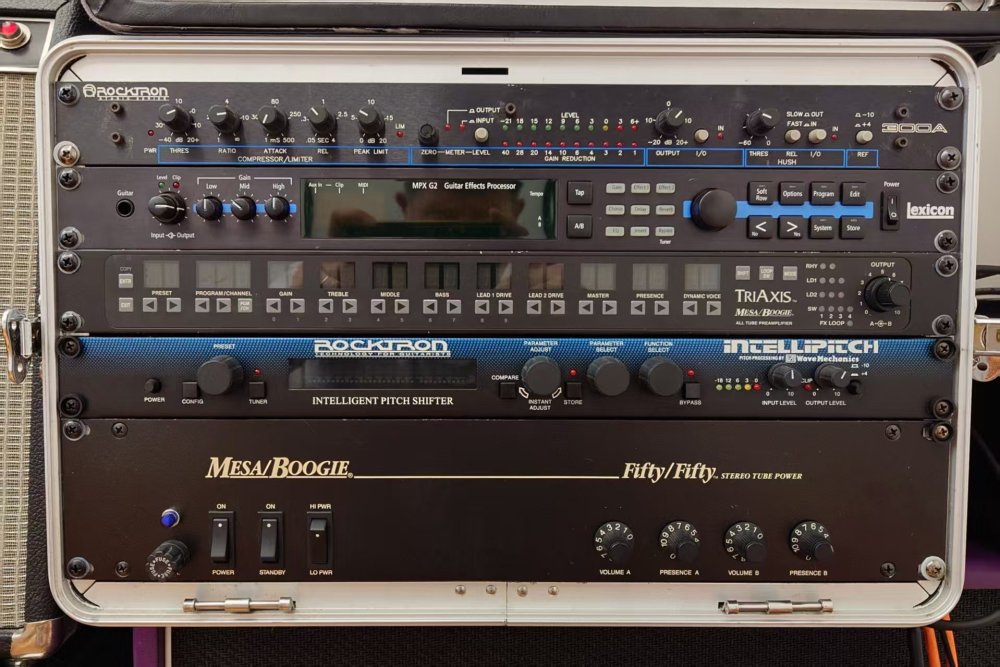Leaderboard
Popular Content
Showing content with the highest reputation since 01/11/24 in Posts
-
5 points
-
I don't think I've posted here before - I'm a member of basschat.co.uk, but after playing bass for decades, lately I've been singing and playing mandolin and octave mandolin. I don't actually play guitar, though I have a couple of guitar-shaped objects in my collection - an acoustic guitar bodied octave mandolin, and earlier this year a local guitar builder converted a copy of a Gibson SG to mandolin for me. I'm currently working towards a Rock School grade 2 acoustic guitar exam... with a mandolin!5 points
-
4 points
-
I picked up a super cheap Ibanez S670 with a fake body for 1500RMB ten days ago and went about upgrading, fixing and customising it with chrome Gotoh hardware and Dimarzio Satriani signature pickups. I wanted to do a Chromeboy painted finish but it's not possible to do it well on wood bodies. The original Chromeboys had finish cracking and bubbling issues do to wood expanding and contracting with seasonal changes, the follow ups had bodies made of lucite not wood. So I did the next best thing - bought a load of mirror vinyl wrap online and found a friendly auto wrapping firm to do it for me after my own attempt failed miserably. The reflection isn't 100% sharp but only really noticable when you are standing closer than 5 meters. I'm planning on using the guitar for a show coming up on Jan 11. The good thing of vinyl over paint is that I can get it re wrapped if it starts to look a little worn.4 points
-
To better appreciate this event, I would refer you to a previous post here, where the 'back story' is quite fully related, so doesn't need repeating here. Skip it if you're in a hurry, but you'll be missing out. Soooooo... I've just, in the past few days, taken delivery of a new (to me, but not quite...) guitar that has been on my 'bucket list' for over half a century. A fellow member of our sister site (Basschat...) passed me a link to a site where this quite rare guitar was for sale, in Sweden. After looking up my finances (it was not cheap...), I contacted the Seller I 'bit the bullet', and, after some tractation over acquisition of a hard case for shipping, it finally arrived, safe and sound, snuggling up nicely in a brand new case. 'OK', I hear you ask, 'but what guitar is it..?' You'll have guessed if you'd read the post in the link above; it's a Hofner President Thinline E2 Florentine, from the late '60s, the same model that I foolishly 'let go' in my stoopid youth. Yippee..! Here's the photos I hastily took as it arrived... Pleased..? You betcha; pleased as Punch. I'm now struggling to get back to where I was, all those decades ago, trying to play a chord-melody version of 'Misty'. By a horrible coincidence, I had trimmed my nails, on both hands, and will have to wait a while before playing that way, as I have done since year 'dot', with only fingers, so I'm struggling at the same time with the use of a plectrum. It's all good, though, albeit extremely slow going. I have a Chromebook for displaying a Pdf of the version I'm using (from a Sandy Sherman YouTube video; just about the best and most accessible I've seen...), but as soon as I think I've assimilated a few bars, I turn the page to continue, but have forgotten it when I turn back again. I'm using my usual method of learning the 'outro' first, so that I'll be working into 'known' territory as I move forward, but, for now (it's been only a few days, but...) I'm finding it quite a job remembering only these dozen or so bars. It'll come (it has to..!), and I find the neck of this guitar to be exactly fitted to how I play (perhaps 'muscle memory' from all that time ago, when I learnt on that first President...). Anyway, enough rambling; back to the Chromebook for another session. I'll see about better pictures if/when the weather picks up, for outdoors lighting. Bye for now... Douglas4 points
-
3 points
-
What a palava. OK so GC has been offline for a few days due to a mix-up in transfer of content from the old server (which was upgraded due to email notification issues on BC) to the new server. The old server subscription cancelled last week taking GC down with it. Then we had issues trying to get things set up on the new server. As you can see, we have managed to restore GC but the only back up on the old server was from January. Sorry sorry sorry sorry sorry to any of you who had made the effort to post detailed or lengthy replies during that time, I've personally lost at least one lengthy post as well. If you need to flame, go ahead. We had to unravel a whole load of secondary issues to do with databases not working quite right, upgrades not installing quite correctly, DNS and nameservers not being what they should be. However, thankfully, we have made it through the other side and GC is faster and more stable than ever. I don't expect this perfect storm to happen again and thanks in advance for your patience and understanding.3 points
-
Decided to get the Epi Les Paul 60’s Standard in Bourbon Burst I had looked at PRS but decided this is what I wanted. Out of the box the quality, setup was spot on and amazing for a £500 guitar. Sounds excellent and pickups are very good and sounds great clean and overdriven They have definitely improved since I owned an Epi Les Paul Plus Top Pro about 10 years ago this is as close to Gibson quality you can get without the price tag ! Awesome guitar3 points
-
On Saturday we had a work party where we provided the entertainment. About six weeks ago I rounded up a bunch of colleagues and proposed we do a song together. Below is the result: 52fb7b34b4790dbaf517c3d5cce802d3.mp4 It was my first time performing on guitar and I used the instrument mentioned here: All sorts of technical issues that I won't bore everyone with but the band had no right sounding as good as this recording suggests. I originally rehearsed with a 4U rack containing my beloved Triaxis and MPXG2 into a Marshall 20/20. But there were 60Hz hum and phasing issues so I swapped the rack for a Kemper and used a profile of the Triaxis instead with only marginal improvement (no more phasing). The Kemper went into two Hotone Loudster Class D power amps sat on a pair of Joyo 1x12 cabs loaded with Celestion Neo Creambacks. The speakers struggled to disperse, but this shouldn't have been too much of an issue if we had been given PA support. Unfortunately the video stops just before I move up front for the solo guitar breaks. I did the thing though - one foot on the monitor. No hair in the wind unfortunately.3 points
-
Hi there! I just joined a new band called Sons of steel. This is one of our singles: Let me know your opinion about it. Thanks!!3 points
-
This year a Joyo "Oxford Sound" pedal. So far I'm very pleased with it - lets me go straight into our PA without lugging an amp around.3 points
-
When singing a melody through, in your head or out loud, try to pick out the highest and lowest notes, when you get to them. That's when to pick up the guitar and find those notes, and only those notes. That'll determine where on the fingerboard the rest of the melody lies, so, having established the extremes, now find the initial, starting note, keeping in mind these extremities. Does this help..?3 points
-
A few years ago I bought a Blue Ridge 12 string with the confidence that I would soon be able to remove my finger picks and apply my scruggs style technique to the 12 string and be able to emulate the one and only Leo Kotke.......... Well, it did kind of sound like him, if he flipped his guitar to lefty and played it with his bare feet. just had to get that off my chest. So sad2 points
-
J. Bright, The Law Suit, late 1700s: There truly is nothing new under the sun...2 points
-
2 points
-
Yes to both, not helped by intermittent focus in my eyesight and a reluctance to take my reading glasses everywhere in case it brings on mid life crisis.2 points
-
2 points
-
I blame the advent of GPS. ...2 points
-
We're stoked to announce that we've launched some new multipacks... https://www.rotosound.com/blog/product-news/new-rotosound-multipacks/ These offer our most popular sets in 3- and 10-set boxes for cost-saving and convenience. Starting from £21.95 for the triple pack and £69.95 for the ten-set multipack, they're available now from UK dealers!2 points
-
Hah! Lucky I'd just swallowed my tea when I got to "Rickenwaffe" - not heard that one before! Yeah, they are more on the ball than anyone I've ever seen about their marks. Ric copies of any serious closeness only exist in Japan that I've ever seen... the very occasional one on ebay disappears almost immediately. I'd love a Ric solod body - a 4003 bass even moreso, but I'm resigned to the fact I'll never be able to afford one (and even then I'd struggle to justify the spend, tbh). Part of me wishes they'd do a diffusion line, A Rickensquierphone. They'd surely sell well, given their absolute nixing of the market for any other options if it's a Ric you want. (The Harely Benton options are about the only ones I've seen, and they're so deviated from the original - even if nice instruments in their own right.... you'll not see a Beatles tribute act playing them the way I've seen them use a Squier to recreate Rocky, let's put it that way...). Another part of me rather respects Ric for deciding they're happy as they are rather than just chasing the lifestyle brand market, or otherwise squeezing their property for every last penny. It was a remarkably late registration attempt by Fender - real stable door / bolted horse stuff. Trademarking a shape wasn't an issue for them in 1951 -or 1954 - as it wasn't until 1960 that you could trademark a shape in US law. The first registered US trademark shape was the Coca Cola bottle, a shape they'd been using since 1916, so I doubt Fender would have had any trouble registering The Tele, Strat, and other shapes then. As memory serves they had the foresight to at least trademark the shape of their headstocks, though.... Similarly, they were behind the curve in the UK as well, where shape-based trademarks became an option under the Trade Marks Act 1994. Gibson seem to have been more effective here, though from my casual awareness of their legal efforts (not least the PRS case), most of their real protection falls in the zone of lawfare.... i.e. Gibson can afford to spend a lot more than most of those they go after, and fighting a lawsuit will most of the time be far more expensive than just tweaking your design a little to make it go away. Smoke and mirrors to some extent once you see the eminently sensible decision by the Appeal court in Gibson v PRS.2 points
-
If anyone is interested there’s a massive guitar, amp and music memorabilia auction on 10th June in Corsham, Wiltshire spanning 5 days. Imagine owning 500 guitars!! https://www.easyliveauction.com/catalogue/5abe5b32c7710c2b409b15545ad1d718/0af8d24542e81eb9357e7ef448a6646f/the-guitar-sale-five-day-auction-including-the-gordon-gi/?currentPage=12 points
-
And it's done. Had to do a lot of routing to get the bridge located properly including plugging and redrilling one bridge post 1mm further way. The wiring was a challenge, I spent three days of eliminating possible causes to arrive at only one conclusion, the pickup selector switch was faulty. My midboost preamp didn't work and I wasn't going to spend a week trying to troubleshoot it, so I bought one only to discover that the guy who build it didn't include separate earth and -9v wires. So had to jury rig something up to provide the output socket with an earth connection, the boost is definitely warm but it lacks the glassiness I expected. So I have on order a genuine Demester Fat Boost (Tyler style) and at some point I will probably wire the switches so they are series, phase and parallel. Although they were fiddly to solder as well. However, after a fret levelling and proper set up, it plays very nicely and has more sustain than my other two strats. I have no idea why. It's quite a warm and loud sounding guitar as well acoustically. More aging is needed on the sides and back but I have other things to attend to in advance of being in the UK next month.2 points
-
A common mistake is for folk to stick to the minor pentatonic when improvising, whether the key or chord is major or minor. Try and make sure you’re complimenting the chord by emphasising the 3rd note. A lot of players tend to play through the scales from one end to the other. Stand out from the crowd by making some interesting, intervalic jumps (Carl Verheyen is the king of this, check him out). Don’t be in a hurry to show your chops too early, build to a crescendo and release (the solo from Stairway is a great example of this).2 points
-
2 points
-
Wouldn't surprise me. The older I get, the more I realise 99% of the electric guitar market is about selling branding an intangibles far over the actual, physical product. It does seem to vary by location, though: players in the US on average still seem to be much more likely to be emotionally invested in the idea that a guitar made in the USA *must* be superior, or is somehow otherwise "the real thing". Which I suppose shouldn't be surprising given that's where the electric guitar boom started, and so there's a sense of "loss" that those aren't dominant in the market any longer - as opposed to being "only" another import product as they are for us in the UK.2 points
-
I am a musician and teacher based on the west coast of Ireland. I teach online lessons across Ireland, the UK and the rest of Europe. I play electric, Acoustic and Spanish guitar in a variety of styles. My influences are diverse, from Led Zeppelin and Pink Floyd to John Williams, SRV, Rory Gallagher and Tommy Emmanuel. Music was my 2nd love, but it's the one that never left me. (a good line for a blues).2 points
-
Steady on, it's not like some of them need extra reasons to slap a premium on a five quid set of parts.2 points
-
Gordon Smith, although better known for their Gibson types, also do a very nice Tele - https://www.gordonsmithguitars.com/shop/stock-guitars/blaggards/ TBH, though, I'm not sure that's how I would go. Clearly you're not looking for a more affordable alternative to Fender's US or CS ranges if you're thinking of spending that sort of custom money anyhow. Now, this is only a personal opinion, but.... for me it would depend a lot on what you want. A tele is such a utilitarian design that if what you want is the standard set-up Tele, it seems to me madness to spend custom-built money on it. If that's the only way - you want something really offbeat like the Jack White signature, or a Trussant Steelcaster, or you have an original 52 that you want to clone so you can leave the vintage piece at home and play a facsimilie out.... then, sure. But if what you want is "just" a Tele, it seems to be it's hard to justify spending vast sums on it.... I'd buy whatever MIM / Tokai / whatever you like and maybe rewired if you want, or track down a CIJ Fender that's good to go as is. (IMO, the top end Japanese Fenders are as good as anything form the US, typically wired the same with the same specs, and usually cheaper - nut much harder to find.) Unless you want something that's just not available otherwise, imo having a custom built Tele is a bit like having a Saville Row tailor copy a pair of 501s for you. They'll be an exquisite example, but....2 points
-
Many thanks for the feedback both. Seems that what I want to achieve isn't quite in the remit of my amp. I might just go back to my comfort zone of 90s solid state.2 points
-
I have friends that bought some Mosky overdrives and they're good. But I can only attest to owning the Mosky Pure Buffer and it's a good buffer, so good that I moved my two VHT Valvulator 1's to my rack. My friend bought the Golden Horsie and it is just as good.2 points
-
2 points
-
I had already pre-empted Christmas in offering to myself my bucket-list guitar : a Hofner President E2 thinline, Florentine cut, having foolishly traded away the first one I had, late '60s. Half a century later, I got this one from a Reverb seller in Sweden. The Christmas gift..? Our Daughter, thinking (rightly...) that it would be difficult to find something I'd want/need that I didn't already have, posted a sum of money into my bank which covered the cost of the hard case and shipping of my dream guitar. Much appreciated, and a Very Nice Surprise. Here's a (bad...) photo of the delivery and unpacking of the guitar...2 points
-
I’d love an L5, or an ES175 at a pinch, but I’m quite attached to my kidneys.2 points
-
This year: A book on jazz guitar comping concepts.2 points
-
Ordered a pair of matched JJ EL34 tubes and swopped out the Marshall stock EL34 ( will keep as spares ) Replaced V1 and V2 with JJ ECC83S Pleasing results as it sounds warmer, fuller and less harsh at high gain which the better JJ tubes seem to be helping A nice easy upgrade2 points
-
2 points
-
There are posting settings saying you need 5 posts to be able to post in general. Seems a bit high, but otherwise, you probably have enough post count to now do it!2 points
-
The DSL20 is EL34 paired and I would say it’s more 80’s to modern day rock I have the DSL20HR and it’s a great amp and can run at home at 10w It will sound much better cranked of course when it really shines The Origin 20 head is better for 60’s 70’s rock and with a drive pedal in front would cover most ground. I had the Origin 50 head in my old band and it was a lovely sound. For home I think the DSL20 is a good choice as it can still gig or jam or play at home Boss Katana is a good choice too but I still prefer valves I briefly tried the Laney Lionheart Foundry 60 but it was poorly built and sounded boxy and average The current production DSL20 is a great small amp. Can be bright sounding but back off the presence and treble and it sounds great. I use a Standard Strat with single coils and play clean and rock2 points
-
I totally agree with this; my Takamine is fitted with these ... ... I have 'etching fingers', which rapidly turn steel or nickel-steel strings to red rust; these 80/20 bronze strings suit the guitar perfectly, with the added advantage of being the same gauge as my electrics and semi-acoustics, all fitted with nano-web sets. They last, for me, much longer than any other make of strings; I previously had to change in less than a year, but these were fitted over a year ago now, and are as good as when fitted, although I admit that I don't play my acoustic every day. It's a joy when one finds the right set for any guitar or bass; I'd even extend this to establishing the best heads for an acoustic drum set..! I used Remo Ambassador heads for decades, but the later choice of Evans Genera and G2 heads made a world of difference..!2 points
-
Ah. For this, I'd refer you to my usual words of encouragement that I often dish out, when subjects such as this arise... 'It's the first forty years that are the worst, after which things sometimes tend to get slightly better.'2 points
-
If, as you say, it's minimal, I wouldn't worry about it at all. There are many guitars (even acoustics...) that are not symmetrically balanced anyway, so even if the wall mount was 'plumb', the weight could well be offset. I've never heard of a guitar neck being affected by being hung this way; they are pretty solidly constructed. If it's only an aesthetic thing, I'd leave it alone. It would be possible to redress things a little, without taking the wall mount down, by winding a piece of cloth onto one side of the mount, as packing, to have the guitar 'plumb'; I'd surely not bother. Hope this helps.2 points
-
dad ive always been a tight git. i just go on ultimate guitar its free. plus ive just started learning to use fl studio which was given to me for nowt so i can make my own drum beats and backing stuff. dunno if you need to have a face book account to wacth this but here is a very short clip of my doing my best Ian mcCulloch impersonation. i was only going to put the chorus bit in and was virtually mouthing the lead up lines but decided to leave them in. ive watched youtube clips of echo and the bunnymen live and i can safely say i "p1ss" all over what he can do nowadays on the high notes. he needs to go on ultimate guitar and transpose it down a bit lol. https://www.facebook.com/alan.jackson.7731/videos/25322994702932342 points
-
ive done some reading and some cheap machine heads are bad and you cant tune down to get it in tune because they just go out of tune too quick, likely by carrying on turning down by themselves. so you have to go lower and then tune up to get it in tune. thats what the seller told me tune back up. and it helped a tiny bit. but they still just turned by themselves no doubt encouraged by string tension. i mean they arent going to tighten up are they? i looked at the design and the worm is designed to be forced in one direction and hence persuaded not to turn. but it can and does. only a tiny bit but thats all it takes. but not now. its perfect thanks to the tiny washers making the screws actually do their job. thanks for trying to help Dad 3353. guitars arent as difficult to set up as people think. i am a builder and diy mechanic and there is nothing i wouldnt take on myself. ive made nuts from scratch even widened the spacing from std. shortened and packed saddles up. plus ive got a ruddy great big hammer.2 points
-
Hello and welcome. Plenty here to learn from and chuckle at. Frustration and patience are your biggest hurdles by the sound of it. You Tube is great, but no replacement for a proper teacher and I would heartily recommend visiting one, even just for a few months to even out your technique. I would also counsel against changing the songs to make them easier, if you only play the stuff you can already play you never progress. Changing them to fit your voice is one thing, but trying to avoid chords just because isn't doing you any favours long term. But also, don't get too hung up on playing them exactly as the records, most of us here can't play everything and do simplify songs to a degree. At the end of the day... just enjoy the journey!2 points
-
2 points
-
A present for myself : a piezo_pre-amp kit to install into my acoustic (holes to be cut into the sides, and the capteur to be fitted under the bridge...). I'll then be able to record without recourse to a mic.2 points
-
i used one continuous oak board (easy cuts) to make this: lots of sanding, some stain, etc. I used the scraps to create supports for the bottom side (given the stomping): i used a 1 3/8" hole saw to cut an opening for wires. i then took that plug and split it in half to make posts, to wrap the excess wire: on the underside, i used wire ties, tacked into the wood, to secure the power lines: in the far corner above, you can see i velcroed the transformer onto the underside. then, velcro on the top, and on the pedals, and a $6 leather handle: then, rubber feet on the bottom, and wire it all together. PS this is not representative of my pedal setup, this is just for testing! i'll post the actual rig soon. it's made it through 6 gigs. hopefully more to come (we have about a dozen lined up!). what i'd change- it doesnt stand on it's side, probably because of how heavy pedals are. to put a stand plate on one side would mess with the aesthetic. what i'm thinking of adding- maybe a shoulder strap so i can make one trip from the car to the studio. i can send plans if anyone wants.2 points
-
Thanks fo the advice. I'll check out somewhere to take it in Manchester when I'm back from hols and get it checked out and set up. Hopefully it's something simple. Thanks again1 point
-
Right, let's try that update again now the server is back up. So there have been a lot of purchases in the last five years mainly due to the sale of a business venture. It's been a lot of fun trying out different gear as you do but reality is starting to bite and I'm running out of space! Guitars: Ibanez AWD83T: In the original post above, I mentioned an Ibanez AWD82 and a few months back I snagged an AWD83T (with trem) on a japanese auction site for a couple of hundred quid plus shipping. It must have been part of an estate sale because it arrived sticky with nicotine stains and rusted strings. However after a bit of cleaning up and new strings, it's a total honey. The factory installed bridge pickup sounds tight and mean when cranked. The bridge pickup could be a little mellower but it still sounds jazzy and the neck is straight as an arrow making for low action. Can't recommend these guitars enough. Sounds better than the Yamaha SAS II I also had my eye on (basically the semi hollow version of the MSG/Image). The Clean Machine: Over the summer two years ago, I took a week out with Jon Shuker to build a body and install the electronics I had been hoarding for a guitar that is intended to satisfy a curiosity about the Aria RS Esprit that was made famous by Alan Murphy and Yngwie Malmsteen in the eighties. It featured Alembic licensed bridge and neck pickups and low pass filters plus a boost feature. I bagged a set of three genuine Alembic Activators off Reverb for 150 quid a few years back and Nuno at Lusithand deserves a huge shout out for customising a set of his DLPF circuits for guitar (and his customer service follow up is nothing short of outstanding as well). Not wanting to rest on my laurels, some Graphtec piezo saddles were installed on the Wilkinson VS100C trem and connected to a Ghost Acoustiphonic preamp. A rotary selector switch was needed to select between 5 pickup positions and the piezo. It still didn't deliver quite the sparkle I was looking for and I theorised it might be because the soft neck wood was dampening some of the higher frequencies. So more recently I had a custom graphite neck commissioned from a guy I know in China and installed it last weekend, it provides more sustain and a more pleasant bell like chime to notes, definitely gets me closer to where I wanted things to be but still lacks a certain something of the original. The really interesting thing is the impact that the filters have on the timbre of any overdrive or distortion, it's surprisingly versatile for recording at least and it's possible to get lots of interesting and not unpleasant sounds when messing about. The sensitivity of the filters make it a little impractical for live use though. Al Knight Hitmaker replica: As much as I like this guitar, it's sort of paid its dues and my tastes have moved on since. So it'll be up for sale over here at some point in the near future. Plays great and sounds exactly like Nile's guitar on the first Chic album. Yamaha MSG Deluxe #1: This was the first MSG I purchased, it's a transition model has the Mach 2 headstock but Mach 1 control locations. It's a little lighter and brighter than number three and in better condition. Not quite as smooth sounding and doesn't have quite the same depth of flame in the top but it's still nice. In a pinch, I would put it up for sale though to make room for other toys...and probably have sellers remorse as a result. Yamaha MSG Deluxe #3: Bought a long time ago, it was the third MSG purchased off Ebay (I think). Number 2 was a sunburst deluxe that was ultimately sold because it was light and bright sounding. This one by contrast is smooth sounding but with a nice midrange punch, even more so after installing my favourite Armstrong pickups so it will do rock and jazz with a flick of the pickup selector switch. Unfortunately the fine tuner screws started wearing out in the proprietary RM Pro trem and the only available replacement bridge chassis was black (off an RG). I actually prefer it in black. Yamaha MSG Standard #4: Originally I bought this because I wanted a simpler guitar and wanted to see how much of an improvement a tune-o-matic style bridge might make to the sustain. I picked it up for cheap because it was in desperate need of a refret and fingerboard dressing. So I took out the frets, carefully reradiussed the 13" radius fingerboard to a slightly flatter 12"radius and installed new frets. As it turned out, the bridge didn't make a whole lot of difference however, I installed some PRS Mira pickups in and it's an outrageous, raw rock machine when paired with the Marshall rack gear. However it may go up for sale in the medium term as the lack of a belly chamfer makes it uncomfortable to play sitting down and while it does rock really well, other guitars can fill the same niche even in a slightly different way and offer more versatility. Kleinberger: I've completely changed my mind about this guitar after trying it through the Marshall rack! While it may not have the most scintilating cleans, when it's cranked there's a real girth to the midrange that punches well above it's relatively small (but wide) size. However, I have another build with a sustainer planned so may let this one go at some point...after I've sorted out a case for it. Rig 1: Guitar rack: This will do pretty much anything from mid eighties onwards. It sounds tight, modern, smooth and well defined. It can do practice volumes as well as performance. Rocktron 300A compressor: This was my first piece of Rocktron equipment and it got broken before I had a chance to try it when a friend plugged in the wrong power supply (it takes AC not DC). So the power caps were replaced and it works fine now. I found it needed some careful dialling in and it sounds OK but not quite as clean as the DBX. However it sits ahead of the Lexicon MPXG2 in the guitar rack now so it does the job it needs to. I probably need to spend more time with it dialling it in. Lexicon MPXG2: I've had two for DECADES and I love them, especially with the R1 foot controller. The only thing on the market that comes close and then offers slightly more versatility with the extra loops is the TC Electronic G system. The MPXG2 was way ahead of its time; the effects chain and routing can be configured at will into parallel, left and right signal paths and in any order. The only limit is processing power, so loading it with compressor, detuning, wah, chorus, delay, and reverb probably isn't going to swing. I took the R1 into my tech earlier this year, and he replaced a lot of worn switch contacts and reconnected the slave power through the 7-pin DIN cable, so now it's as responsive as new. Mesa Boogie Triaxis preamp (x2): One v3 with the v1 British mod in Lead 1 red and the other is slightly older V2 and a little more worn membrane front but it has the recto board which gives recto tones in Lead 1 red. The MkIII (Lead 2 red) is the sound that has been in my head ever since I started learning guitar so both are staying put for the foreseeable future. Just amazing pieces of kit, there's not a bad sound in either of them. Rocktron Intellipitch: Given the limitations of the Intellifex XL (see brelow), I bought this purely for its modulation including 8 voice chorus. It's a fairly rare beast, not many were made - certainly not as many as the Intellifex. Again, like the Intellifex, it lacks a certain sparkle so best suited to parallel signal chains rather than in series, but I have taken all of Leon Todd and others' tri-chorus settings and manually programmed them in. Mesa Boogie Fifty Fifty power amp: I did a gig dress rehearsal with the Marshall 20/20 and it wasn't quite loud enough, so ended up getting a Mesa Boogie Fifty Fifty for about half the price of a 2:90. It almost makes the 20/20 redundant for practice due to it's high (50w) and low (15w) power settings and sounds a little smoother. But it's a lot heavier so I don't know how much of a practical improvement it actually offers. Joyo 112V cabs (x2): Currently loaded with Celestion Neo Creambacks (which aren't available in China), I'm using these with the Kemper pedalboard at the moment but I'm tempted to put the V30's back in as I'm not planning to gig them in the future since getting the Thiele cab made. So the lightweight Thiele cab will stay with the rack and the Joyos with the Kemper pedalboard but the Thiele cab will be gigged regardless of whether the Kemper or the rack comes along too. Rig 2: Vintage I like to use this for songs before the mid eighties. Eagles, Toto etc. Pedalboard Xotic XW1: I originally bought this instead of a Crybaby because it didn't produce a volume drop when disengaged and it can be tweaked to sound like other wah pedals using the tone and Q controls. After I got it, I learned it was a favourite of Paul Jackson Jr and this year, Steve Lukather has been using one with Toto. At the moment I have it set up based on Paul Jackson's settings from one of his YT videos about the pedal. Keeley C4 compressor: This has replaced the Effectrode simply because there is no power bank available on the market that I can run the Effectrode off, so it always needs to have it's own separate power supply and that's really too inconvenient for live use. I did have a Joyo Dynacomp in place before but the footswitch was too noisy and there was some crossleakage under high gain. The Keeley is well made, it fattens and squashes the signal without sounding too intrusive. There are a lot of different kinds of comps on the market designed to appeal to many different tasts but I have no regrets buying this one. Initially I had it in front of the gain pedals but I may just experiement with putting it after. Xotic AC Booster: I had been playing around with various cheap TS and Klon style pedals as boosts into the Amptweaker but while they all fattened and articulated the mids nicely, they were a little flat sounding. So I bought the AC Booster and as soon as I plugged it in, there was some extra harmonic saturation that I had never heard before. It sounds good with the Concert II but really shines when pushing the PRII, the saturation from both seems to synergise into this rich mid range with some lovely thick harmonics and the tone controls allow tweaks to taste. I know some keep the drive below 12 o'clock but I've found that around 1-2 oclock delivers more saturation. Nobels ODR1: I got this pedal to trial but fell in love with how articulate it stayed even with higher gain settings. No wonder it's the favourite of producer/guitarist John Shanks. It also has very juicy levels of harmonic saturation which is enhanced when boosted with the Xotic AC booster. I almost prefer the combination to the sound of the Tight Rock. And into the PRII this combination sounds even better. Amptweaker Tight Rock: See above. Still my favourite high gain pedal. It's not subtle but does plexi and 6505 with almost no noise. Crowther Hot Cake: This was inexpensive and I was really curious about how it sounded after seeing PRS use one. It's sort of half way between fuzz and distortion with a really grungy character if you push the gain into meltdown terrirtory. But back off and it's a very thick and warm fuzz/overdrive. Mine is from the mid noughties so has all the blueberry switch and different options for selecting different versions in previous runs. This one tends to swap places with the Joyo. Joyo American Sound JF14: I mentioned above how good this pedal is and I ended up with two but only really use one. I keep coming back to this one, there isn't a lot out there to beat it apart from the pedal it copied - Tech 21 Blonde. It can do astoundingly god versions of Twin and Deluxe amps and when the mids are pushed using the character, mid eq and drive it will get near Super Champ. Just a great pedal but the components aren't as durable as they could be. TC Electronic MImiq: This is a recent purchase with a view to starting the yacht rock board. Basically it replicates the sound of double tracking using two signal paths with one subtly affected by variations in delay and microtuning. I haven't played around with it much yet so don't have a lot to say about it yet. Zoom MDC70: This was a cheap way to access a trichorus sound. It has a patch that copies a TC Electronic Corona tri chorus setting. It's possible to add two more patches for a total of three accessed with a single button press. I don't have a lot more to say about it at this moment but I'm temped to see how well it can cover the trichorus+micro detune that was made popular by Mike Landau and his frdge of rack effects in the eighties. Mooer Ocean Machine mk 1: There's not a lot out there which can compete with this in bang for buck. The delays are pretty good, the reverb has an artificial sounding presence and I generally turn the shimmer control to zero which kind of reduces the transparency as well. Still, it's not likely to be noticed in live settings. A mark 2 version has been released which updates the algorithm and improves the effects quality but I haven't checked out whether the shimmer is better. Once finances permit, I have plans to overhaul the pedal board and make it more schmoo focussed. So the drive pedals will probably stay but the delay and reverb will be handled in one signal chain by an Eventide Time Factor and Strymon Big Sky, and modulation in another a Free The Tone Triavatar and a Yamaha Magicstomp for SPX90 style detune. Fender Concert II + 1x12 extension cab: Originally in an earlier post, I had planned to let this one go but it's found a purpose in supplying high volume Fender cleans. This was my first Fender and it took eight years to bring it over to China. Cleans are classic blackface, David Gilmour used a bank of them for Live Aid. There are some critics of the distortion but I like the overdrive on mine. It's got tweedy bite to the midrange but sounds smoother and warmer. It's also loud for 60W and, to make it push even more air, I commissioned a custom matching cabinet if I ever want to gig it. Originally the combo came with an Eminence Red White and Blues speaker but I've put Jensen N12Ks from a Tonemaster Twin instead for yet even more midrange articulation. The extension cab is from lightweight birch ply and even with the Jensen installed, it's a two finger lift. Can't say that about the Concert itself though. Fender Princeton Reverb II: I've said a bit about it in the original post. It sounds slightly richer and more saturated than the Concert II but doesn't get gigged due to its lack of power. It's also in fabulous condition and I wouldn't want to risk any road rash. Rig 3: Kemper Profiler pedalboard This was set up for portability (despite weighing at just over 10kg) and is essentially self contained from wireless to power amp. Guitar on back, Thiele cab (with neo cones) in one hand and this in the other makes for a single (just about manageable) load out. I also use this for practice due to it's versatility. First in the signal chain is a standard Shure GLX16 wireless. I've been impressed by the range, and have been able to go walkabout in a 600 seat venue already with no drop outs. Battery life seems pretty good too. Next is a Digitech Freq Out - mentioned in earlier posts, it's essentially a pedal for creating artificial feedback. The onset control is a little twitchy and the effect is unnaturally sensitive to disturbance from incidental noises and changes in volume, but for sustained and undisturbed power chords it does the trick. Then the signal goes into the Kemper which is set up with a bunch of amp profiles in song related 'performances' - basically scene shifts in different parts of the song, or a single setting for one song. I tend to have a bunch of classic amps and then some profiles from the preamps. I've found the profiling process adds a certain sweetness and extra midrange during the profiling process which has led to some profiles sounding better than the real thing. Inserted into a loop in the Kemper is a Line 6 M5 for any effects that the Kemper doesn't have, Dimension D for example, and it's connected via MIDI so specific effects are selected with specific 'performances'. Lastly, there are two Roland EV5 pedals connected for volume and wah and the outputs from the Kemper go to a pair of Hotone Loudster Class D pedal amps that put out 85w a side. They are fairly modern sounding as you might imagine but that's a good thing on a crowded stage, less volume is needed due to the extra articulation in the mids and highs that the Class D circuitry offers. The pedalboard then goes into a Custom 2x12 Thiele designed cab which was optimised and loaded with Celestion V30s which are chunky, heavy things. If I need to gig it in the future, I may just replace the V30s with Celestion Neo Creambacks because of lighter weight and extra articulation from neo magnets. The optimisation of the Thiele port might be a little off but I'll live with it. Other stuff: Ibanez TSA5 combos: One failed on me completely after a power cap exploded and burned the PCB beyond repair. So it got basically tossed out. The other one was getting quieter - maybe also the power caps were on their way out. So I gave it to a colleague at work and it sat under his desk for a solid 7 months. Grand Princeton Tweed combos: These replaced the TSA5s and were made by the company who supplies Peavey with its Classic line of amplifiers. Hand built and point-to-point wired. Pretty loud for 5W and well constructed but I don't really need them any more so they are up for sale. Carvin Quad X preamp (sold): Leon Todd wasn't particularly impressed by it's nine valves but I quite liked it for versatility and organic sound - sort of half way between the rawness of a Mesa Studio and the punch of a JMP-1 but not sounding like either. I discovered a lot comes down to valve choice and EHX 12AX7s sounded great in gain positions. However I kept gravitating to other preamps not because the Carvin was bad but because it wasn't quite the sound that was in my head. Burman GX3 preamp: Mentioned above, I still haven't tried it with the Pro501 (which is for sale in the UK) This does a lovely, almost fuzzy overdrive, almost with the midrange of a Tweed but with more bass. I haven't yet tried it with a rack-mounted power amp either and that could get interesting. Marshall JMP-1 + 20/20 EL84 power amp: Currently up for sale where I am. It's a great sounding preamp by itself but when paired with the 20/20 power amp, together they deliver that classic Marshall roar heard on thousands of rock albums. The nostalgia hit when listening to it being played is almost overwhelming and the JMP1 can do any Marshall amp made before the early ninties from JTM to Plexi to JCM800. Mesa Boogie Studio preamp: was my first purchase and originally it was intended to nix my lust for a (heavy) Mark III. I had the studio preamp in a rack and really didn't like the sound of it when recording. But paired with a rack power amp, it sounds much tighter and less brittle. As nice as it is, I still preferred the versatility and slightly tighter sound of the Triaxis so it's currently up for sale. DBX 266XL compressor: I read online reviews about how coloured this compressor was but when I actually tried it, the warmth and smoothness was surprising. Lexicon MPXG2 seemed to play nice with it as well so it got transferred over to the studio rack where it has been ever since. Really like this one, highly recommended. It may get transferred back to the guitar rack at some point. DBX 215 graphic eq: I don't have much to offer on this. I generally use it for enhancing the sound I get out of the studio monitors, not much more than that. The Yamaha HS5s I have are fairly honest sounding so while they're great for mastering (which I never do) they lack a little sweetness and punch. Rocktron Intellifex XL: I got this for schmoo - a name for that chorusy, reverb-drenched, clean eighties strat sound made famous by Michael Thompson, Dann Huff and Mike Landau. Have to be honest I was a little disappointed by the sound quality, it's not as hifi as the Lexicon MPXG2 and the settings are more limited than the earlier 'Intellifex Online' version. I can only detune in increments of five on the XL where the Online allows detuning in increments of 1. The lack of subtle detuning makes tri-chorus difficult to achieve. Apparently this was done to provide more ROM memory for a more variety of patches. I'm currently troubleshooting the new studio rack, which has been set up for parallel effects so I will see what kind of improvement there is in sound quality in the short term but I get better reverb and crisper delay from the MPXG2 so the Intellifex is currently up for sale. Lexicon MX200 multi effects: This was only 45 quid and I had it in my studio rack for a while until it was time to reconfigure for parallel processing and then it stopped detecting input signal. I have no idea why, and it needs looking at. But basically, it offers Lexicon quality delay and reverb for relatively little money on the used market because there are so many of them around. A bit of a secret. Behringer Virtualiser: I bagged this after seeing it pop up in a number of online reviews and have to say it's quite impressive for the price. There's a transparency and fidelity to the reverb that is almost immersive. It's used in the studio rack for sweetening. There is a whole bunch of other stuff not included because it's not in use, for example an Empress Parametric Eq, Adrenalinn III, Digitech Bad Monkey, Mosky Silver Horse, Joyo Dynacomp etc. All currently up for sale and not significant enough to discuss.1 point




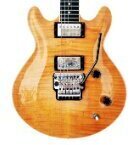

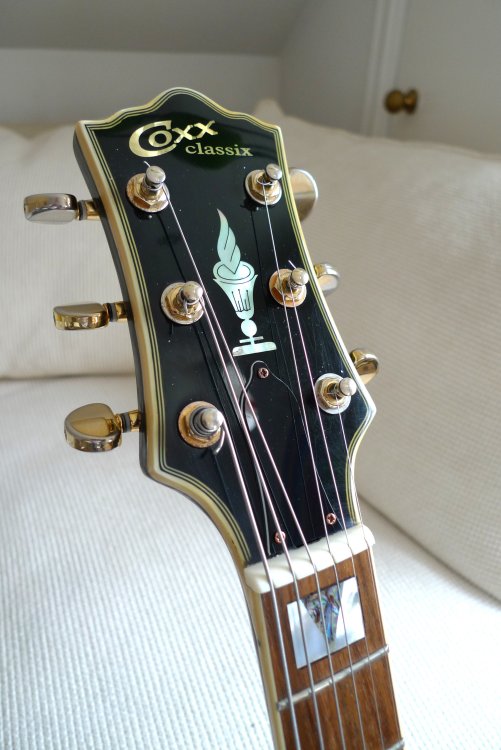



.thumb.jpeg.a8aa32423136d3f8dec9b5734642753a.jpeg)
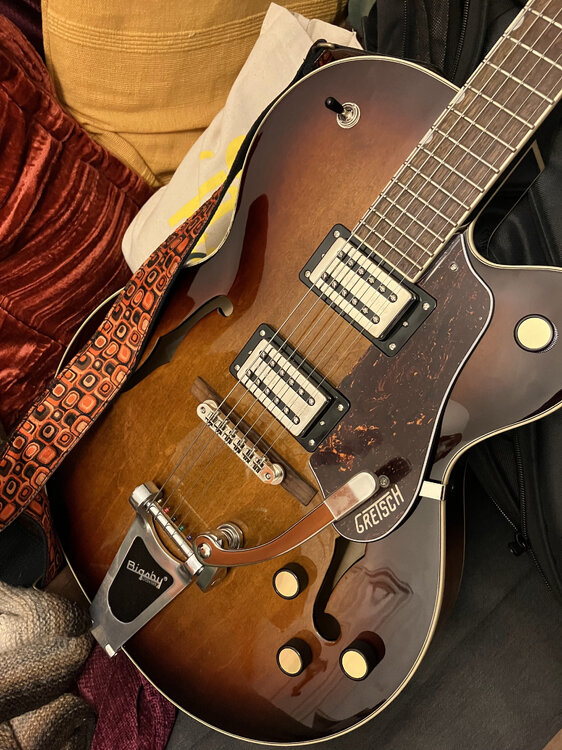
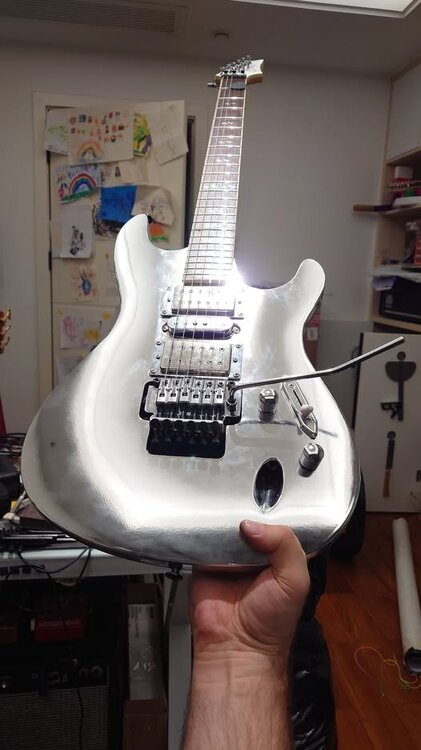




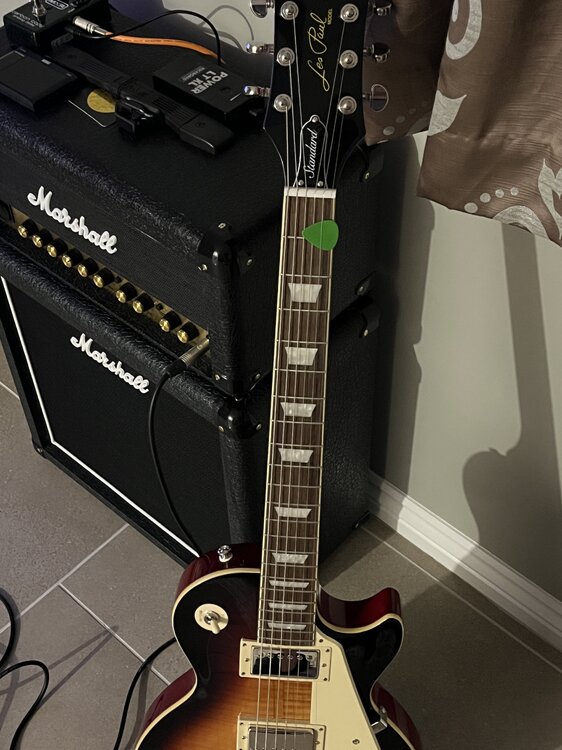


.thumb.jpg.2f0f241a63381e5644f287abacd76760.jpg)
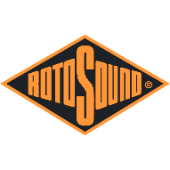
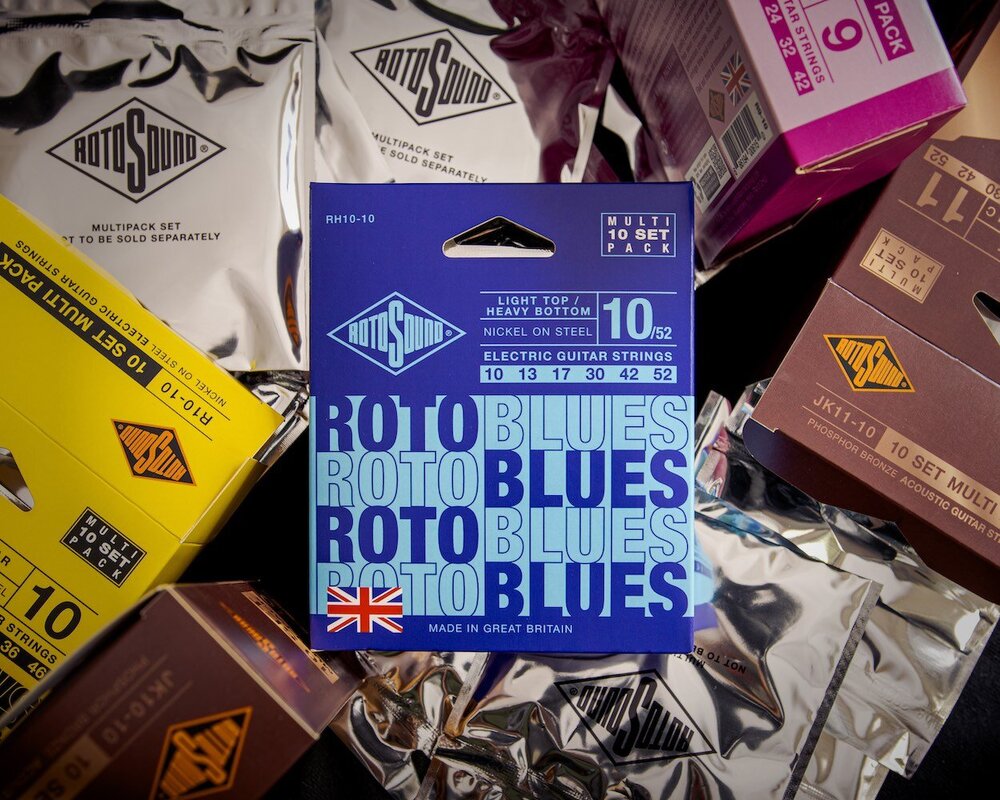

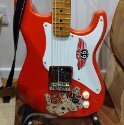
.thumb.jpg.bf04d549e8b000fc7f386743da4de4a9.jpg)
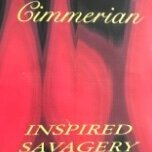


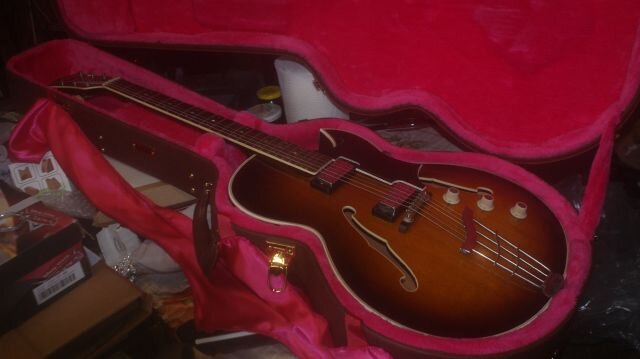
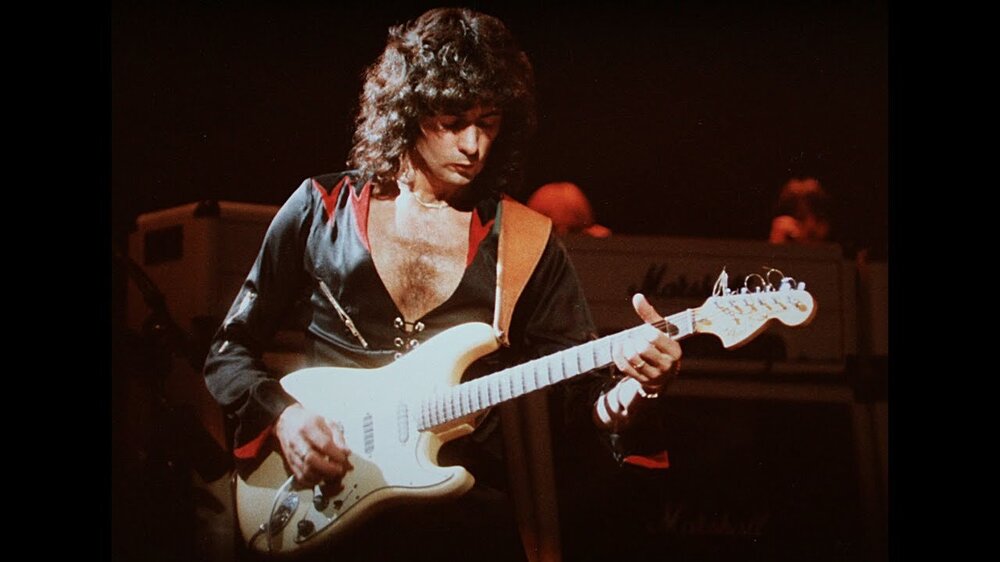
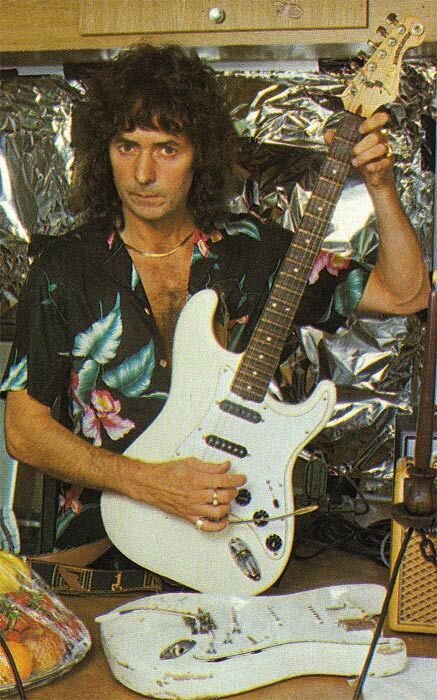
.thumb.jpg.34affd8f5098b09fd5e630707cf875e9.jpg)
